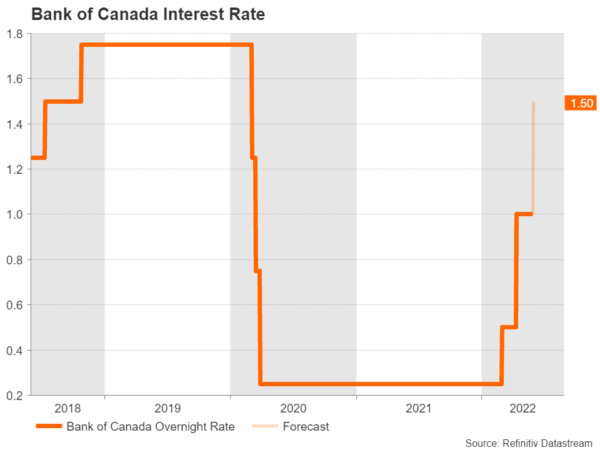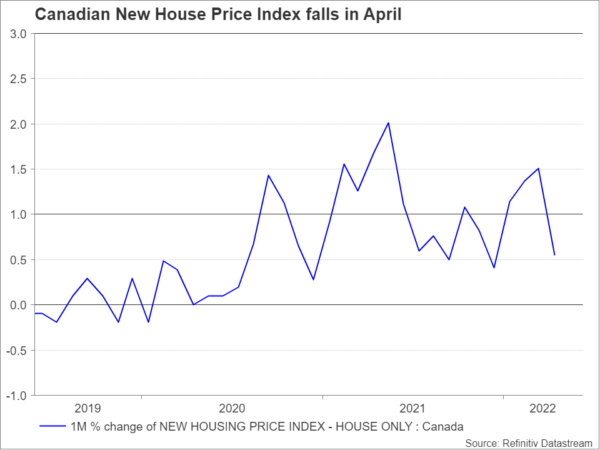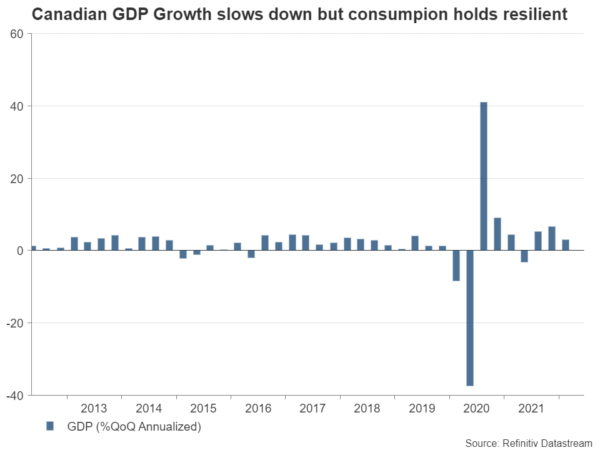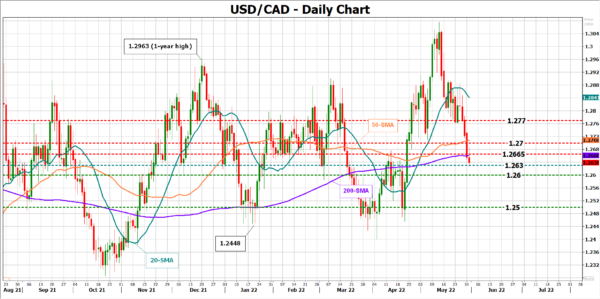The Bank of Canada will probably stick to the script on Wednesday at 14:00 GMT, announcing another jumbo rate hike to rein in inflation. The Canadian dollar, however, may not respond aggressively as investors have factored in the rate announcement, while they also expect additional increases during the next months. That said, any warnings about the drawbacks the rate hike cycle may cause, especially on the housing market, could still generate some volatility.
Another sharp rate increase expected
The Bank of Canada (BoC) ramped up its fight against inflation in April, delivering a double 50 bps rate hike during its previous policy meeting and starting the quantitative tightening phase after a normal 25 bps increase in the preceding month. Despite that, the nonstop Ukrainian war and the exchange of sanctions between Russia and the rest of the world have further exacerbated supply jitters and caused another inflation wave, sending the headline CPI to a new three-decade high of 6.8% y/y in April. The increase in food prices has been even more pronounced and imported inflation has been spilling over in domestic markets as well, raising speculations that similar aggressive rate hikes will follow while some analysts have even blamed the central bank for being late in kicking off the tightening phase.
Governor Tiff Macklem did not rule out similar rate hikes in the future, saying that borrowing costs may need to move above the neutral range of 2-3% for a period of time to bring inflation to the target. As a result, investors have become almost certain that the central bank will repeat the super-sized 50 bps rate increase in June to 1.50% and will not stop there, with futures markets pricing in at least one more 50 bps in the coming months.
BoC to stick to its guidance despite recession fears
The above policy decision, however, will come at a time when traders are grappling with uncertainty about whether the swift monetary tightening campaign will result in a soft landing or will end up in an economic recession. Discouragingly, the housing sector, which is closely watched in the indebted Canadian economy, has started to show some signs of weakness as the ratio of household debt to disposable income fluctuates at a record high as of 2021Q4. Specifically, home sales dropped by 12.6% m/m in April for the first time in two years and the home price index edged down but remained strongly elevated on a yearly basis.
Following up, quarterly GDP growth figures on Tuesday created some discomfort after revealing a lower-than-expected annualized expansion of 3.1%, though the data did not alter rate hike expectations as domestic consumption sped up on the back of higher labor compensations, offsetting the pullback in exports from temporary supply constraints in the oil sector. The private savings rate rebounded as well, though it remained comfortably below the pandemic peak.
Overall, the Canadian economy is still in good shape and although the diminished labor pool may add constraints to economic growth, the BoC will probably wait for more data evidence that its aggressive strategy is harming the economy before it changes course.
Hence, given the status quo, policymakers will probably stick to the rate hike plan and avoid any serious language twists, and specifically the word recession, as investors are sensitive to any changes in economic outlook.
USD/CAD
Looking at dollar/loonie, the pair is facing resistance around the 200-day simple moving average (SMA) and the 1.2665 level. For the pair to bounce above 1.2700, the central bank will need to adopt a less hawkish tone, signaling potential adverse economic effects from rate increases and opening the case for an earlier slowdown in the rate hike path than analysts expect.
Otherwise, if the BoC undermines the latest deceleration in the housing market, feeling confident that the economy can absorb additional sharp rate hikes in the year ahead, dollar/loonie could plunge below the 1.2630 – 1.2600 support region and towards the 1.2500 number.


















